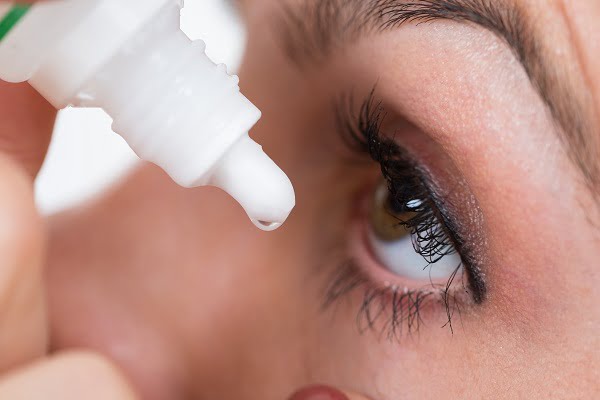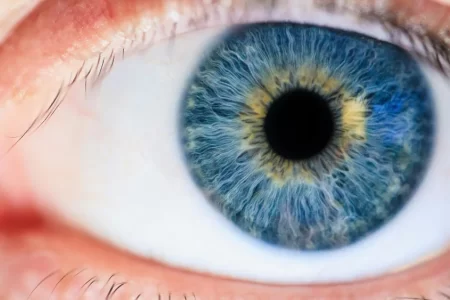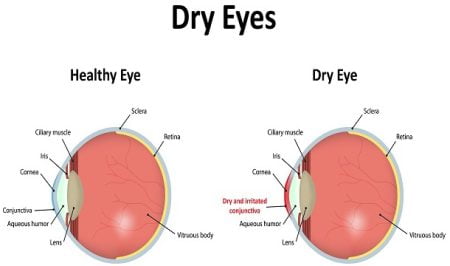Eye Drops for Dry Eyes (Artificial Tears or Eye Lubricants): How to Relieve Dry Eye Syndrome?
- Updated on: Jul 15, 2024
- 4 min Read
- Published on Apr 22, 2021


Dry eyes are a common eye affliction. This eye condition can be caused by many different reasons. Dry eyes can be part of the aging process or a symptom of another disease.
Eye drops are generally the preferred method of treating dry eyes by doctors. Many prescription and over-the-counter eye drops are available that a doctor may choose from and recommend for you based on your condition.
What are artificial tears for dry eye syndrome? Which eye drops are best for dry eyes?
Artificial tears also called artificial lubricants for dry eyes are products available as eye drops to help people who suffer from dry eye syndrome (also called dry eyes simply). Artificial tears are generally available as over the counter medicines at most chemists and pharmacists.
These eye drops are often called artificial tears because they replace the missing water in the tear film of your eyes. However, they don’t contain many chemicals that are present in natural tears such as the antibodies, vitamins and nutrients found in normal tears that are important for eye health.
There are so many types of artificial tears that it can be quite difficult to choose the one eye drop that is best for you. Many people keep trying one another before they find one that woks good for them. But this approach of self-medicating and self-diagnosing is not correct. It is important that you meet a qualified eye doctor and get your eyes examined thoroughly to identify the medical reason for your dry eyes before trying several different products. Your doctor will help you find the right eye drop for dry eyes (artificial tears).
See also: Tests And Diagnosis Of Dry Eyes (Dry Eye Syndrome)
See also: Causes Of Dry Eye Syndrome
Types of eye drops for dry eyes (artificial tears types)
There are a number of eye drops to consider for treating symptoms of dry eyes. These include such as:
- Artificial tears: Artificial tears are the most common treatment method for treating dry eyes. These are usually available over the counter at pharmacists but it is recommended to consult a doctor before using them for longer periods. It may require some trial and error for people to identify the artificial teardrops that work best for them.
- Lifitegrast: Lifitegrast is a small molecule integrin antagonist to reduce T cell-mediated inflammation. It is available through medical prescription.
- Autologous blood serum drops: These eye drops are made from a patient’s own blood. Autologous blood serum eye drops are used in cases where a patient’s dry eyes are not responding to other treatments. A sample of your blood is taken and red blood cells are removed from it to prepare eye drops for dry eyes treatment. Because of quality standards, the process of preparing these medicines can take several months before the treatment is available to use.
- Cyclosporine: It is a prescription medicine used as eye drops to help treat certain infections that might be causing dry eyes. It allows the eyes to produce more tears.
OTC eye drops and prescription eye drops for dry eyes
Most of the over-the-counter (OTC) eye drops contain humectants, lubricants, and electrolytes. . Humectants are substances that help in retaining moisture in eyes. OTC eye drops for dry eyes are available in various forms such as conventional eye drops, gels and ointments. Gels and ointments can stay longer in the eyes, so they’re recommended for overnight use.
Prescription eye drops are available only with a doctor’s recommendation. They may contain substances that help treat your chronic dry eye problems. Cyclosporine is a prescription eye drop for dry eyes. It helps treat inflammation of the eye that might be the cause of your dry eyes. Cyclosporine is recommended for long-term use. It can cause side effects. Your doctor will evaluate your condition and whether the drug causes any ill effects on your eyes.
Eye drops with preservatives and eye drops without preservatives
There are two types of eye drops for dry eyes – drops that contain preservatives and those that do not contain any preservatives.
Preservatives are added to eye drops to prevent the growth of bacteria. But, preservatives may cause problems in some people. Examples of drops with preservatives are HypoTears, Soothe Long Lasting, and Eye Relief. These are usually not recommended in serious cases of eye dryness.
Drops that do not contain any preservatives are recommended for people with moderate or severe dry eyes. Few examples of eye drops without preservatives are Refresh, Systane, and Ultra TheraTear.
See also: Treatment For Dry Eyes
What’s in artificial tears (lubricants)?
Mild to moderate cases of dry eye syndrome are often treated using lubricant eye treatments that consist of a variety of drops, gels and ointments.
Artificial tears try to mimic natural tears of eyes. They contain a combination of various ingredients such as:
- Lubricants to keep your eyes moist
- Electrolytes, such as sodium and potassium, which help heal the surface of your eye
- Preservatives to prevent bacterial growth
- Guar gum can help if you get dry eyes because your tears dry up quickly
Viscosity of artificial tears
Artificial tears are available with different viscosity. Artificial tears with low viscosity are light and watery. They can provide quick relief with little or no blurring of your vision. But their effect is very short-lived, and sometimes you have to use these eye drops very frequently to manage dry eyes.
Artificial tears or lubricant eye drops that have a high viscosity are more like gels and can provide longer-lasting lubrication effect. But these drops cause blurring of your vision for a few minutes after you apply them. Therefore, doctors recommend these drops for overnight use and not for use during your work day or for tasks where you need clear vision such as driving, reading.
When to use artificial tears?
You can use artificial tears if your eyes are dry. They are your first line of treatment to prevent and manage eye dryness. Their main function is to keep the surface of your eyes moist. They mimic the natural tears of your eyes. You might have to do lot of trial and error to find the right eye drop for you, but it’s always a good eye to use them after consultation with an eye doctor (ophthalmologist).
Other than artificial tears, there are two other types of eye drops that are generally used for eye conditions. These are:
- Allergy eye drops
- Anti-redness eye drops











